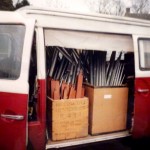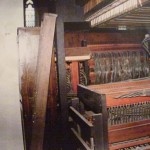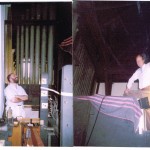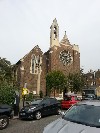A story of three organs
 I am Robert Bowles, Director of Music at the Church of the Holy Spirit, Clapham, and Chairman, St Paul’s Cathedral Chorus and Guild of the Companions of St Paul.
I am Robert Bowles, Director of Music at the Church of the Holy Spirit, Clapham, and Chairman, St Paul’s Cathedral Chorus and Guild of the Companions of St Paul.
I want to tell you the story of our organ.
So, firstly tell me about the history of the church
It was dedicated 102 years ago. There was no church in this part of Clapham because the area was undeveloped. Just a few large houses with vast gardens. From about 1870 they were sold off and the grid of streets with terraced houses took the population from 500 to 8000. The church was designed to accommodate 600!
And the organ?
This was built by Alfred Hunter and Son, whose works were nearby in Clapham High Street, in 1921. When the church was dedicated there were plans to fit out the interior quite quickly, including building an organ. The First World War disrupted those plans, and inflation eroded the value of the money that had been collected. Even with a significant grant from Andrew Carnegie, lots of the organ was “prepared for” but not installed. Behind the three manual console was a two manual instrument with space to install what was missing! Our predecessors were wise and realistic. Everything they did was to a high standard of design, materials and workmanship. If there wasn’t enough money to do something properly, they didn’t try and do it on the cheap – they just didn’t do it. We have the original contract for building the organ which describes very clearly what was in the first phase, and what was to happen later. After the first phase was complete further fundraising allowed three of the missing ranks to be installed, but by the mid-1980s the 60-year-old leatherwork was starting to disintegrate, so the focus was on restoring the instrument that we had got, not completing it.
So how did you deal with that?
That’s when I was appointed organist. The layout of the organ within the gallery is excellent, and if you know where to crawl you can get to any of the pneumatic machines without dismantling anything. That makes ordinary maintenance quite straightforward, individual components can be removed if they need work in the workshop. I inherited a scheme to re-leather everything gradually whilst never taking the whole instrument out of action. Then William McVicker, one of our Diocesan Organ Advisors and a SSLSO member, suggested we should apply to the Heritage Lottery Fund for a grant. He thought that although incomplete, the organ was an excellent example of its age and type, largely because it had not been altered in the 1960s. Our bid for grant-aid was successful, and we got further grants from the ON organ Fund and the Council for the Care of Churches. So once we had raised the rest we were able to restore the whole of the original instrument in one go. So it is now in perfect working order. Our organ builder and SSLSO member Vincent Coggin did an amazing job.
But the instrument looks pretty complete now – how did that come about?
Our discussions with the HLF included a proposal to complete the organ. They were supportive of the idea, but funding it fell outside their terms of reference (“We are able to fund the restoration of existing heritage but not to buy new heritage”). They imposed an interesting but understandable condition, which was that it had to be completed to the original design, using second hand material known to have originated in Hunter’s works, or new material copied from a Hunter original.
 We did some further fundraising and started a Hunter hunt. Paul Joslin of BIOS led me on a treasure trail which finished in the loft space of the garage of the Vicarage in Catherington, near Portsmouth. There I found all the Hunter pipes from an organ removed from the church some 10 years previously with the intention of re-installing them in a new action. That scheme had been abandoned as there was no prospect of raising the money. We got consent to buy these pipes. Click the photo or link to see 13 more photos of the Catherinton effort. http://slickpic.us/768866yjOO?play
We did some further fundraising and started a Hunter hunt. Paul Joslin of BIOS led me on a treasure trail which finished in the loft space of the garage of the Vicarage in Catherington, near Portsmouth. There I found all the Hunter pipes from an organ removed from the church some 10 years previously with the intention of re-installing them in a new action. That scheme had been abandoned as there was no prospect of raising the money. We got consent to buy these pipes. Click the photo or link to see 13 more photos of the Catherinton effort. http://slickpic.us/768866yjOO?play
Michael Toll led me to the United Congregational Church in Lee-on-Sea, near Southend. They had a project to re-develop their church and hall to provide residential accommodation and a smaller worship space into which their two-manual Hunter organ would not fit. So we bought the complete instrument. Click the photo or link to see 8 photos of the dismantling of the organ at Leigh-on-Sea. http://slickpic.us/768874mNA1?play
 With the aid of voluntary labour we brought everything back to Clapham and sorted out what was needed for the church organ, disposing of the rest. We had almost everything that was missing, including a soundboard, reservoirs and a swell box for the choir organ. Click the picture or the link to see 6 photos of the first stage of the work at the Church of the Holy spirit. http://slickpic.us/7688804MkN?play
With the aid of voluntary labour we brought everything back to Clapham and sorted out what was needed for the church organ, disposing of the rest. We had almost everything that was missing, including a soundboard, reservoirs and a swell box for the choir organ. Click the picture or the link to see 6 photos of the first stage of the work at the Church of the Holy spirit. http://slickpic.us/7688804MkN?play
Vincent Coggin re-leathered and restored everything that needed it, and we re-erected it in the  space prepared for it all those years ago. We used more volunteer labour, mostly graduate structural engineers from my office. Click on the photo or link to see 12 photos of the installation of the organ in the Church of the Holy Spirit. http://slickpic.us/768878Q2j1?play
space prepared for it all those years ago. We used more volunteer labour, mostly graduate structural engineers from my office. Click on the photo or link to see 12 photos of the installation of the organ in the Church of the Holy Spirit. http://slickpic.us/768878Q2j1?play
All that is missing now are the 16ft Trombone on the pedal and the 16ft Contra Fagotto on the swell. I can’t find them anywhere!
The end result is a huge success, and the whole instrument has great integrity despite the various routes that components have taken to get here from the factory only a mile away.
Can you demonstrate this?
There are two video for you to see.
 The first starts with me playing a quiet piece ending with a louder piece. I also give a short commentary . Click on the picture or the link to see the video which last just over 4 minutes. https://www.youtube.com/embed/2CvqPf82nCI
The first starts with me playing a quiet piece ending with a louder piece. I also give a short commentary . Click on the picture or the link to see the video which last just over 4 minutes. https://www.youtube.com/embed/2CvqPf82nCI
The second is a recording of 17 separate stops or stop combinations. Click here to hear the individual and combination pipe sounds.
And how is the organ used now?
Click here to download the full current specification.
Well, we use it every Sunday for our main service, and we are gradually introducing evening prayer on Sundays.
We have three organ students who regularly use it for private practice, and three more who come occasionally.
The PCC is keen for it to be used, so we’d welcome any approaches from students of any age. We are developing links with the RCO organ academy. The organ is also available to any of the other musical groups which are starting to use the church for rehearsal, recording and for concerts.
Any other thoughts?
If anyone knows where I can get a Hunter Trombone and Contra Fagotto – get in touch!
| Note: Vincent Coggin is a former Chairman of the Society and now lives in Norfolk |
Previous My Church’s


